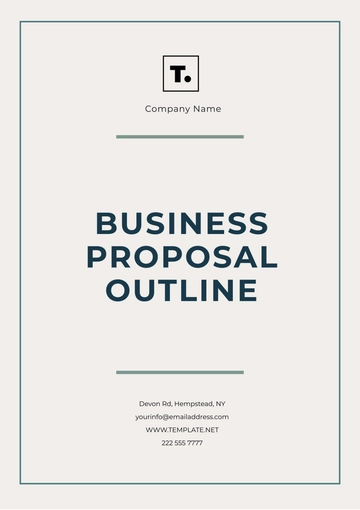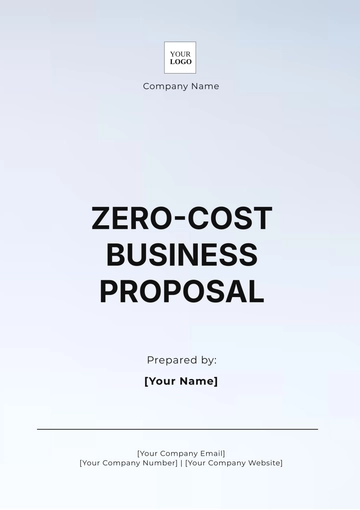Free Franchise Business Outline Proposal

1. Executive Summary
Business Overview: Provide a brief description of the business, including its history, mission, vision, and the products or services offered.
Franchise Opportunity: Highlight the potential for franchise growth and why this business model is viable for franchising.
Objectives: State the short-term and long-term objectives for expanding the business through franchising.
2. Company Overview
Founding and History: Describe when the business was established, by whom, and its growth journey so far.
Current Operations: Provide details on the current operations, locations, customer base, and profitability.
Business Model: Outline the existing business model, how it works, and what makes it successful.
Brand Strength: Showcase the brand's reputation, customer loyalty, and market presence.
3. Franchise Model Overview
Franchise Concept: Define the core concept of the franchise, including product/service offerings, customer experience, and operational standards.
Franchise Type: Clarify the type of franchise (e.g., single-unit, multi-unit, area development).
Target Franchisees: Describe the ideal franchisee profile, including qualifications, experience, and financial requirements.
4. Market Research and Analysis
Industry Overview: Provide insights into the broader industry the business operates in, including current trends, challenges, and growth prospects.
Market Opportunity: Analyze the target market, identifying customer demographics, demand, and competitors.
SWOT Analysis: Highlight the business's Strengths, Weaknesses, Opportunities, and Threats, particularly in relation to franchising.
Competitive Landscape: Identify key competitors and explain the business’s competitive advantages.
5. Franchise Structure and Operations
Franchise Package: Detail what the franchisee will receive, including operational support, marketing support, training, and access to proprietary systems.
Franchise Fees:
Initial Franchise Fee: The upfront fee for purchasing the franchise.
Ongoing Royalties: Define the percentage of gross sales or revenue the franchisee will pay to the franchisor.
Marketing Contributions: Explain the franchisee’s contributions to local or national marketing funds.
Training and Support:
Initial Training: Describe the training process for new franchisees.
Ongoing Support: Outline ongoing support services such as business coaching, marketing support, and operational guidance.
Territory: Define the territory rights given to franchisees (e.g., exclusive or non-exclusive).
6. Franchise Development Plan
Expansion Strategy: Outline the strategy for franchising, including target markets (local, national, international).
Timeline: Provide a proposed timeline for franchise development, including key milestones for launching franchises.
Marketing the Franchise: Detail the strategy for attracting potential franchisees, including advertising, franchise expos, and partnerships.
Franchise Agreement: Include a brief overview of the legal structure of the franchise agreement (with lawyers preparing a full draft).
7. Financial Projections and Investment
Initial Investment: Breakdown of the costs to start the franchise, including franchise fee, equipment, inventory, and working capital.
Revenue Projections: Provide financial projections for franchisees, including revenue, profit margins, and break-even timelines.
ROI for Franchisees: Estimate the expected return on investment and how long it may take for franchisees to recoup their investment.
Financial Support: Discuss if financial assistance or partnerships with lenders will be available to help franchisees.
8. Legal Considerations
Franchise Disclosure Document (FDD): Mention that a full Franchise Disclosure Document will be provided, containing detailed legal and financial information.
Intellectual Property: Outline the brand’s trademarks, patents, copyrights, or any proprietary systems.
Compliance: Ensure compliance with local, state, or federal franchise laws and regulations, as well as any industry-specific regulations.
Dispute Resolution: Provide an overview of how disputes between franchisors and franchisees will be managed (arbitration, mediation, etc.).
9. Risk Factors and Mitigation
Potential Risks: Identify risks that may affect the success of the franchise, including economic downturns, competitive threats, and operational issues.
Mitigation Strategies: Discuss strategies to minimize and manage risks, such as diversification, financial reserves, and ongoing training.
10. Conclusion
Summarize the key benefits of the franchise opportunity.
Reaffirm franchisee support and growth potential.
Encouraging potential franchisees to join the franchise.
11. Appendices
Franchisee Application Form: Include a sample application for potential franchisees to fill out.
Franchise Disclosure Document (FDD) (Optional): If not provided, mention that it will be available upon request.
Sample Financials: Provide a sample of profit and loss statements or balance sheets to give a clearer picture of financial expectations.
FAQs: Frequently asked questions by potential franchisees.
- 100% Customizable, free editor
- Access 1 Million+ Templates, photo’s & graphics
- Download or share as a template
- Click and replace photos, graphics, text, backgrounds
- Resize, crop, AI write & more
- Access advanced editor
Template.net's Franchise Business Outline Proposal Template is designed for franchise owners and prospective franchisors. Fully customizable and editable in our AI Editor Tool, this template helps you outline franchise terms, operational details, and financials. Perfect for creating a compelling franchise pitch, it provides a professional structure to attract investors or partners for your business expansion.
You may also like
- Business Proposal
- Research Proposal
- Proposal Request
- Project Proposal
- Grant Proposal
- Photography Proposal
- Job Proposal
- Budget Proposal
- Marketing Proposal
- Branding Proposal
- Advertising Proposal
- Sales Proposal
- Startup Proposal
- Event Proposal
- Creative Proposal
- Restaurant Proposal
- Blank Proposal
- One Page Proposal
- Proposal Report
- IT Proposal
- Non Profit Proposal
- Training Proposal
- Construction Proposal
- School Proposal
- Cleaning Proposal
- Contract Proposal
- HR Proposal
- Travel Agency Proposal
- Small Business Proposal
- Investment Proposal
- Bid Proposal
- Retail Business Proposal
- Sponsorship Proposal
- Academic Proposal
- Partnership Proposal
- Work Proposal
- Agency Proposal
- University Proposal
- Accounting Proposal
- Real Estate Proposal
- Hotel Proposal
- Product Proposal
- Advertising Agency Proposal
- Development Proposal
- Loan Proposal
- Website Proposal
- Nursing Home Proposal
- Financial Proposal
- Salon Proposal
- Freelancer Proposal
- Funding Proposal
- Work from Home Proposal
- Company Proposal
- Consulting Proposal
- Educational Proposal
- Construction Bid Proposal
- Interior Design Proposal
- New Product Proposal
- Sports Proposal
- Corporate Proposal
- Food Proposal
- Property Proposal
- Maintenance Proposal
- Purchase Proposal
- Rental Proposal
- Recruitment Proposal
- Social Media Proposal
- Travel Proposal
- Trip Proposal
- Software Proposal
- Conference Proposal
- Graphic Design Proposal
- Law Firm Proposal
- Medical Proposal
- Music Proposal
- Pricing Proposal
- SEO Proposal
- Strategy Proposal
- Technical Proposal
- Coaching Proposal
- Ecommerce Proposal
- Fundraising Proposal
- Landscaping Proposal
- Charity Proposal
- Contractor Proposal
- Exhibition Proposal
- Art Proposal
- Mobile Proposal
- Equipment Proposal
- Student Proposal
- Engineering Proposal
- Business Proposal





























